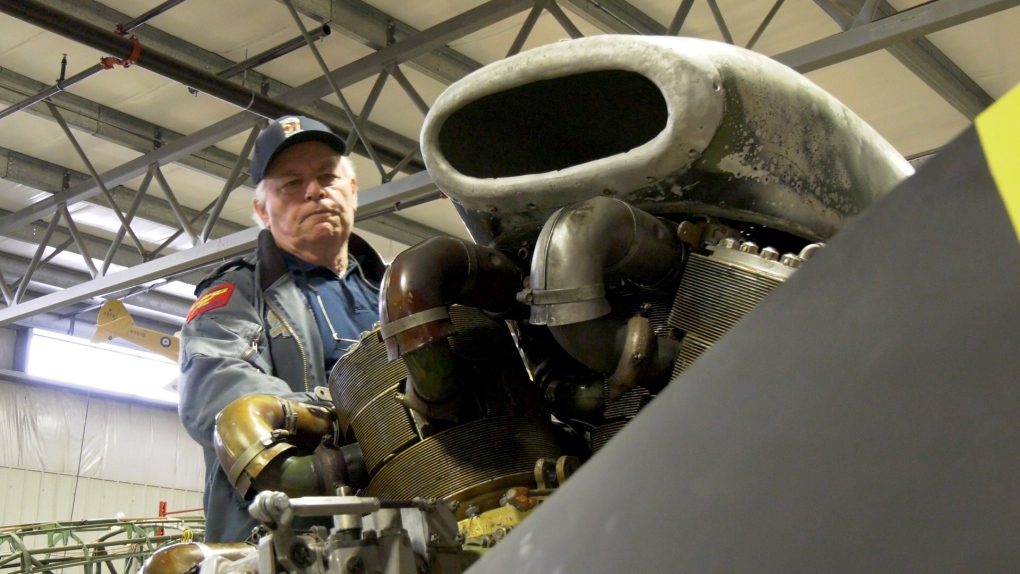‘Finding parts all over the world’: Inside an Alberta museum’s Halifax bomber project

Karl Kjarsgaard is the curator of the Bomber Command Museum of Canada in Nanton, Alta., and says he has spent more than a decade searching for parts of the Halifax bomber.
His most recent find was one he found while vacationing in Montana and Idaho.
Kjarsgaard says he learned of a person who had some turret parts that could be from the Second World War aircraft.
“I walk into his storage container and here’s all the pumps, motors and seats for a Halifax tail turret sitting in his container at the Idaho Falls airport,” he said. “So bless him, he gave me everything.”
Kjarsgaard says he never knows where parts for the historic aircraft may turn up.
He currently has two working Bristol Hercules engines and more parts that can be used to build two others.
Kjarsgaard says he found four engines in Terrace, BC, two in Malta, two in Leeds, England and one in Glasgow, Scotland.
In Oakland, Calif., Kjarsgaard found an air scoop that is used to direct air into the engine compartment.
He says he’s developed a good relationship with the aircraft community all over the world who notify him when they find a part.
“You could work with the blueprints, but the icing on the cake of restoring an airplane is if you have the real McCoy part,” he said.
“Even if it’s corroded, between the real part and the blueprints you can (design) a template and make a brand new part, and that’s the key to a warbird restoration.
“We’re finding parts all over the world.”
There were 6,100 Halifax bombers built in the early 1940s for the war effort and today only three remain.
“There’s one Halifax that’s in Trenton, Ont., that is totally rebuilt, looks brand new,” he said.
“That was my team that lifted it out of a lake in Norway (and had it restored), and there’s another Halifax, unrestored at the Royal Air Force Museum (in London, England), and then there’s another Halifax on display in York, England (at the Yorkshire Air Museum).”
Kjarsgaard heads Halifax 57 Rescue that raises awareness about the bomber on its website, but is also a vehicle to raise funds to purchase parts and pay for projects.
For the last few years, the main project is off the Swedish coast in the Baltic Sea where 78 years ago, a Halifax with a Canadian crew from the 405 RCAF squadron had to bail out after loosing two engines.
They all made it out safely and the pilot pointed the aircraft out to sea.
“It went out about 10 or 12 miles out into the Baltic and hit the water quite hard,” he said. “It wasn’t really a ditching, but the thing is it laid there in the sand being covered up by the sand for over 78 years.”
He and his crew have been able to salvage a variety of parts for the bomber that will be used in its restoration. The RAF museums in London and Yorkshire both had 16 metre wing ends for the Halifax in their inventory that were collecting dust in storage and will soon make their way to Canada.
“They were donated to our Halifax project,” said Kjarsgaard. “So the RCAF in its 100th anniversary year is hauling the wings across the ocean to Trenton, Ontario for our Halifax rebuild so we’re greatly appreciative of their support.”
Kjarsgaard says the wing assembly is being built in Ontario and eventually all the parts will make their way to Nanton where they’ll be assembled
“The Bomber Command Museum has the engines, the propellers, the landing gear, the turrets, all of that will be done here,” he said.
“And guess what, we don’t have enough room here at Bomber Command Museum to assemble a Halifax so what we’re doing is a major funding drive to get a second huge hangar added to our complex.”
Kjarsgaard is hopeful work on the hangar will take place in the next few years once funding is secured.
Learn more about the project here: https://fundrazr.com/campaigns/417498
View original article here Source









